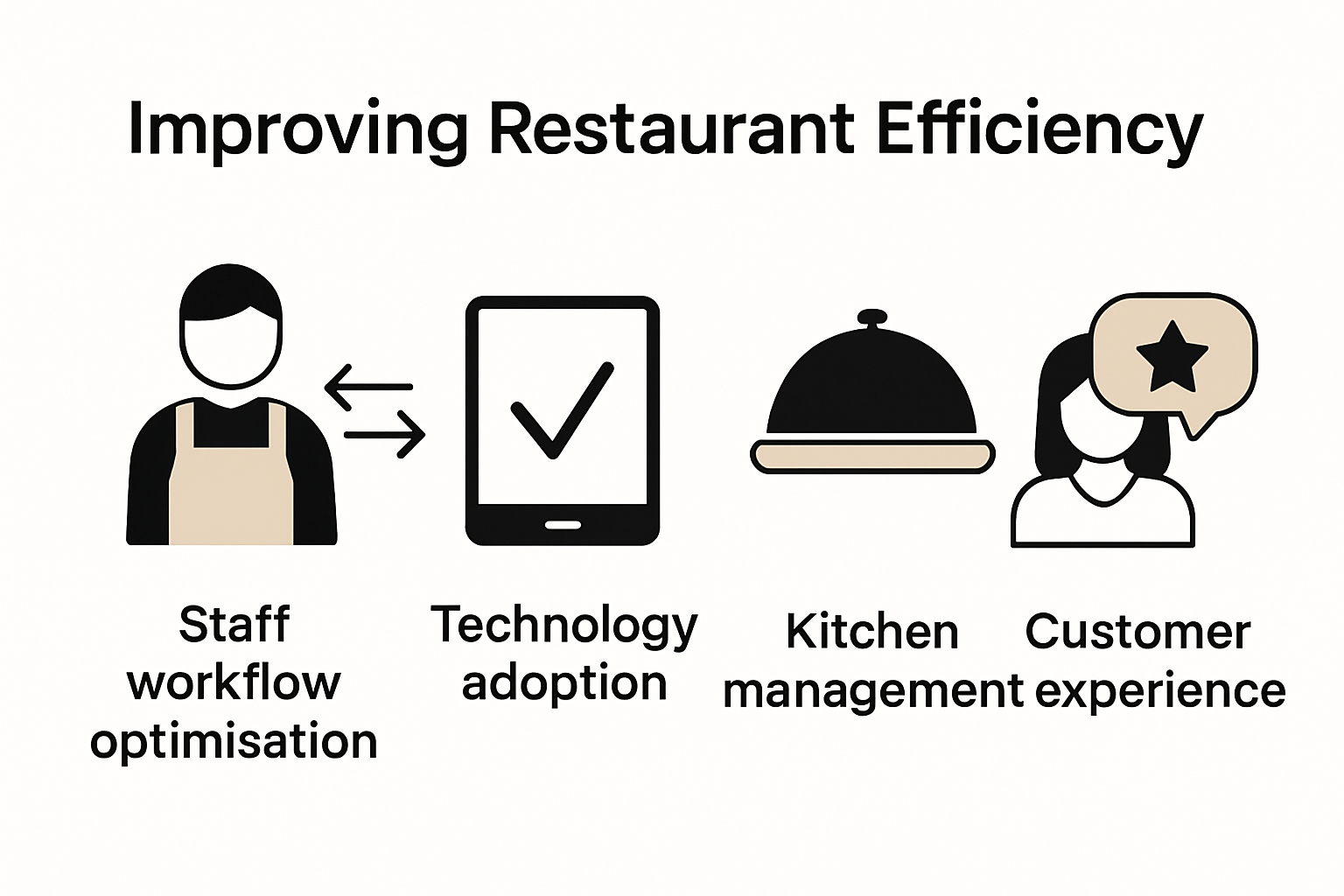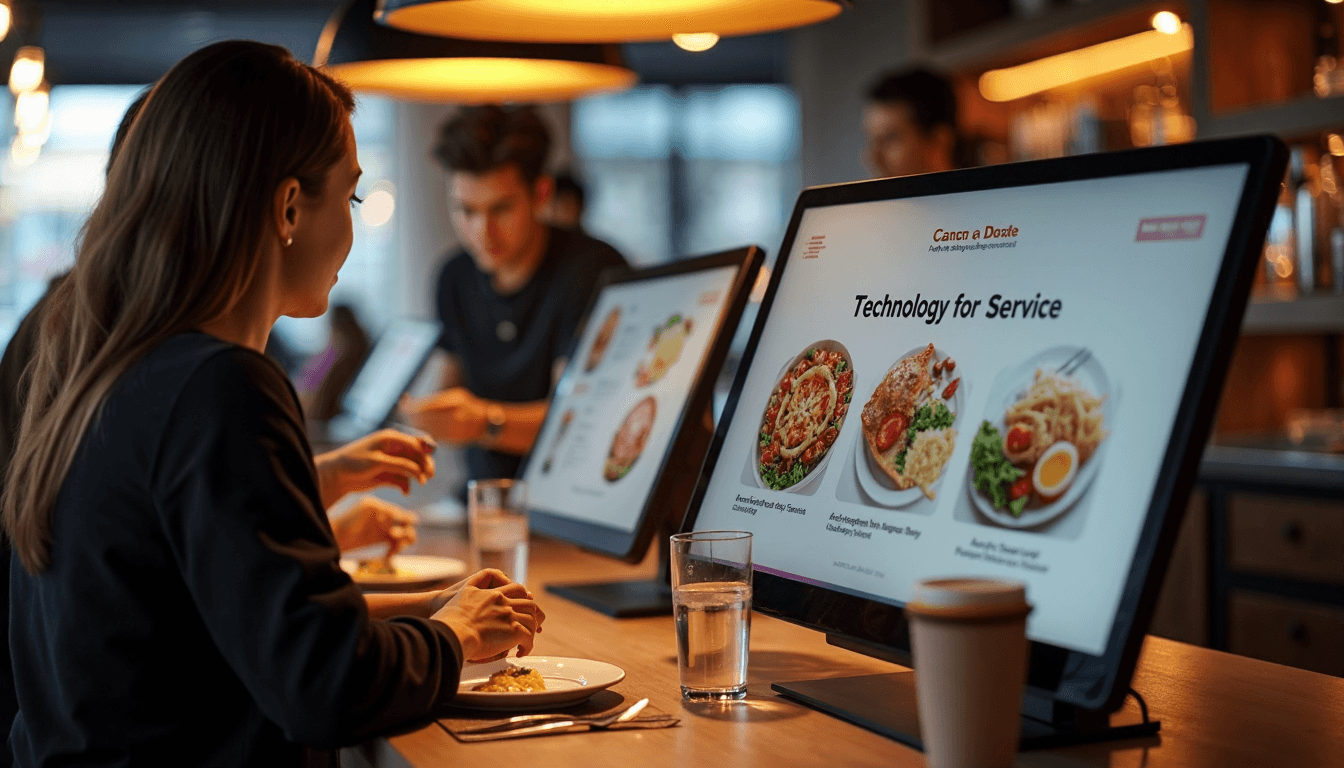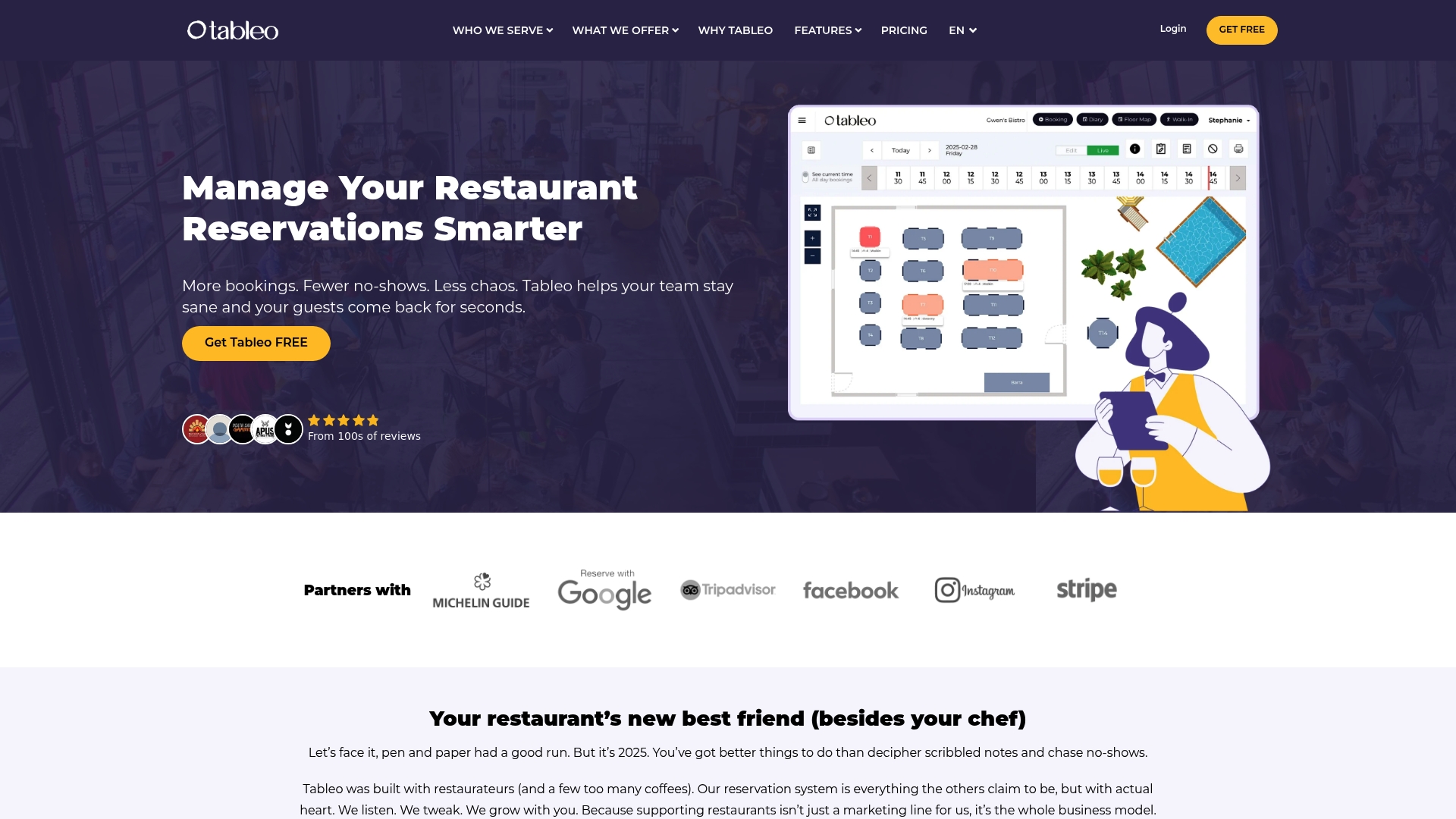Restaurant owners are searching for every possible edge as competition heats up in 2025. Yet, while many obsess over new menu items or trendy interiors, they often miss the most dramatic gains hiding in plain sight. Here is the truth: restaurants that adopt automated inventory management can reduce food waste by up to 15 percent and trim costs faster than any recipe change could ever achieve.
Table of contents
- Optimising Staff Workflow And Training
- Leveraging Technology For Faster Service
- Streamlining Kitchen And Inventory Operations
- Enhancing Customer Experience And Turnover
Quick summary
| Takeaway | Explanation |
|---|---|
| Cross training for flexibility | Implementing cross-training programmes allows staff to perform multiple roles, enhancing operational agility and reducing service disruptions, especially during peak periods. |
| Leveraging technology for service | Utilising innovations such as automated ordering systems and AI-driven customer interactions can significantly improve service speed and efficiency, leading to enhanced customer satisfaction. |
| Optimising kitchen workflow | Employing strategies like the FIFO method and advanced inventory management systems can prevent spoilage, reduce waste, and ensure high-quality food preparation processes. |
| Personalised customer engagement | Integrating AI and predictive analytics in customer interactions fosters personalized experiences, increasing satisfaction and encouraging repeat patronage. |
| Streamlined operations through automation | Automating tasks through self-service kiosks and mobile applications minimises errors and enhances customer control, resulting in faster table turnover and an overall improved dining experience. |
Optimising staff workflow and training
Improving restaurant efficiency demands a strategic approach to staff workflow and training that goes beyond traditional methods. Modern restaurants require dynamic systems that transform how employees learn, collaborate, and execute their responsibilities.
Cross training for maximum flexibility
Cross training has emerged as a critical strategy for enhancing operational agility. By enabling staff to perform multiple roles, restaurants can create a more resilient workforce capable of adapting to unexpected challenges. Learn more about performance enhancement strategies for comprehensive workforce development.
According to research from Tork, implementing cross-training programs can significantly reduce operational bottlenecks. Staff who understand multiple aspects of restaurant operations can seamlessly transition between roles during peak periods, minimizing service disruptions and maintaining consistent customer experiences.
Digital learning and performance management
Technology has revolutionized staff training approaches. Digital learning platforms enable restaurants to provide real-time, accessible training materials that employees can engage with flexibly. Xenia’s research highlights that mobile solutions and digital tracking platforms improve learning outcomes and operational efficiency.
Key technological interventions include:
- Interactive training modules that allow self-paced learning
- Performance tracking systems to monitor individual staff development
- Mobile-accessible resources for instant knowledge retrieval
Standardising operational procedures
Consistency is the backbone of efficient restaurant operations. The Access Group research emphasizes establishing clear, standardised workflows that reduce errors and create predictable service standards.
Implementing comprehensive standard operating procedures (SOPs) involves:
- Documenting step-by-step processes for each restaurant function
- Creating clear communication channels
- Regular training and performance review mechanisms
By investing in staff workflow optimization and continuous training, restaurants can create a more adaptable, skilled, and efficient workforce prepared to meet the dynamic challenges of the hospitality industry in 2025.
Leveraging technology for faster service
In the rapidly evolving restaurant industry of 2025, technological innovation has become the cornerstone of service efficiency. Explore our insights on restaurant automation tools to understand how cutting-edge solutions are transforming dining experiences.
Intelligent order and delivery management
Technology is revolutionising how restaurants process and fulfil orders. Research from arXiv introduced a groundbreaking reinforcement learning framework for meal delivery platforms, demonstrating significant improvements in order dispatching and courier management. This advanced system ensures:
- Optimal route planning for delivery couriers
- Fair workload distribution across service networks
- Real-time efficiency adjustments to minimize delivery times
The study revealed that intelligent routing algorithms can reduce delivery times by up to 22%, creating a more streamlined service experience for both restaurants and customers.
Augmented reality in service enhancement
Augmented Reality (AR) is emerging as a game-changing technology in restaurant service. A 2024 study explored AR applications that transform dining environments, highlighting remarkable benefits:
- Customizable table setups through AR interfaces
- Dynamic lighting control to enhance ambience
- Reduced perceived waiting times
- Increased customer psychological ownership of dining experiences
Restaurants implementing AR technologies report improved customer satisfaction and more engaging dining interactions.
Automated service technologies
According to research published in the Journal of Hospitality and Tourism Technology, emerging technologies like service robots, self-service kiosks, and automated cooking systems are reshaping restaurant operations. While these technologies offer significant efficiency gains, the research emphasizes the continued importance of human interaction and skill.
Key automated technologies include:
- Robotic food preparation systems
- Self-ordering kiosks
- AI-powered customer service interfaces
- Automated inventory management
By strategically integrating these technologies, restaurants can create faster, more efficient service models that balance technological innovation with human expertise. The future of restaurant service lies in intelligent, adaptive systems that enhance rather than replace human capabilities.
Streamlining kitchen and inventory operations
Effective kitchen and inventory management represents a critical frontier for improving restaurant efficiency in 2025. Explore our comprehensive guide to inventory management best practices to unlock significant operational improvements.
Advanced inventory management strategies
Modern restaurants are transforming their approach to inventory control through data-driven methodologies. Research indicates that implementing automated inventory management systems can reduce food waste by up to 15%, translating into substantial cost savings.
Key strategies for advanced inventory management include:
- Real-time tracking of ingredient stock levels
- Predictive analytics for demand forecasting
- Automated reordering systems
- Integration with point-of-sale platforms
By leveraging data analytics, restaurants can decrease food waste by 25%, gaining precise insights into stock levels and sales trends.
Below is a table summarising the main benefits and features of advanced inventory management strategies mentioned above, for easy reference.
| Strategy | Key Benefit | Feature/Statistic |
|---|---|---|
| Real-time Tracking | Immediate stock awareness | Prevents over-ordering & shortages |
| Predictive Analytics | Accurate demand forecasting | Reduces food waste by up to 25% |
| Automated Reordering | Maintains optimal inventory levels | Reduces manual errors and stockouts |
| Integration with POS | Unified sales & inventory insights | Enables data-driven purchasing decisions |
| Automated Inventory Management | Substantial cost savings | Food waste cut by up to 15% |
Optimising kitchen workflow
According to restaurant management experts, implementing the First-In, First-Out (FIFO) method prevents ingredient spoilage and minimizes waste. This systematic approach ensures older stock is utilized before newer inventory, maintaining food quality and reducing unnecessary expenditure.
Effective kitchen workflow optimization involves:
- Standardised preparation processes
- Efficient workstation design
- Clear communication protocols
- Regular equipment maintenance
Technology-driven kitchen management
Cutting-edge technology is revolutionizing kitchen operations. Digital solutions now offer unprecedented visibility and control over complex restaurant environments. Integrated management systems enable chefs and managers to:
- Monitor ingredient usage in real-time
- Track kitchen performance metrics
- Predict potential supply chain disruptions
- Automate administrative tasks
To help clarify, here’s a table outlining the main technology-driven solutions in kitchen management and their associated benefits.
| Technology Solution | Benefit |
|---|---|
| Real-time Ingredient Monitoring | Reduces waste; maintains quality |
| Performance Tracking | Identifies operational bottlenecks |
| Supply Chain Disruption Prediction | Prevents stock shortages or delays |
| Task Automation | Frees up staff for core kitchen tasks |
| Integrated Management Systems | Easier performance management |
By embracing these technological innovations, restaurants can create more responsive, efficient kitchen ecosystems that adapt quickly to changing demands while maintaining high standards of food quality and operational excellence.
Enhancing customer experience and turnover
Restaurant success in 2025 hinges on creating exceptional customer experiences that drive repeat business and optimize table turnover. Learn strategies for building lasting customer loyalty to transform your dining establishment.
Personalised digital interactions
Research from RestroWorks highlights the transformative potential of AI-driven customer interactions. Implementing advanced technological solutions enables restaurants to deliver highly personalised dining experiences.
Key digital interaction strategies include:
- AI-powered chatbots for instant customer support
- Predictive ordering suggestions based on customer preferences
- Customised marketing communications
- Real-time feedback mechanisms
These technologies can significantly reduce response times and enhance overall customer satisfaction by providing tailored, immediate engagement.
Streamlined ordering and payment systems
According to Wikipedia’s research on automated restaurants, incorporating self-service technologies dramatically improves operational efficiency and customer experience. Automated ordering and payment systems offer multiple benefits:
- Reduced waiting times
- Greater customer control
- Minimized human error
- Faster table turnover
Self-service kiosks and mobile applications empower customers to manage their dining experience independently, creating a more flexible and responsive service model.
Predictive customer experience management
Advanced restaurants are now leveraging predictive analytics to anticipate and exceed customer expectations. RestroWorks research demonstrates that predictive inventory management systems can:
- Analyze historical sales data
- Forecast demand patterns
- Ensure consistent availability of popular menu items
- Reduce food waste
By understanding and proactively addressing customer preferences, restaurants can create more engaging, efficient dining experiences that encourage repeat visits and positive word-of-mouth recommendations.
The future of restaurant success lies in seamlessly blending technological innovation with personalized, high-quality service. Restaurants that master this balance will not only improve operational efficiency but also build stronger, more loyal customer relationships.
Frequently asked questions
What are the most effective strategies for improving restaurant efficiency in 2025?
Implementing cross-training for staff, leveraging technology for faster service, optimising kitchen and inventory operations, and enhancing customer experience are key strategies for improving restaurant efficiency.
How can technology enhance service speed in restaurants?
Utilising automated ordering systems, AI-driven customer interactions, and self-service kiosks can significantly speed up service and improve overall customer satisfaction.
What role does inventory management play in restaurant efficiency?
Advanced inventory management strategies, such as real-time tracking and predictive analytics, can reduce food waste by up to 15%, allowing restaurants to save costs while maintaining quality.
Why is personalised customer engagement important for restaurants?
Personalised customer engagement, driven by AI and predictive analytics, enhances customer satisfaction and encourages repeat visits by providing tailored experiences that meet individual preferences.
Take your restaurant efficiency Beyond 2025’s standards
You have seen how critical automation, streamlined bookings, and real-time guest management are for restaurant success in this rapidly shifting landscape. The article revealed how digital tools and data-driven processes cut food waste, reduce service delays, and increase customer loyalty. Yet, a gap remains between knowing what to do and finding the right system to make it happen.
If reducing no-shows, boosting table turnover, and handling bookings effortlessly are your top priorities, see how Tableo’s reservation management platform turns these strategies into daily wins. Discover how features like custom online forms, integrated payments, and automated reminders help you deliver exceptional guest experiences while streamlining operations. Act now to start building a smarter, more agile restaurant with Tableo.
Recommended
- Boosting restaurant profit & financial stability – Tableo
- How To Increase Restaurant Capacity with Efficiency Tips
- Easy Ways to Improve Your Restaurant Capacity – Tableo
- Restaurant Sustainability. Top 5 Tips on Going Green
- How to improve restaurant staff performance. 9 step guide
- Techniques for mastering multi-chain management
Ready to take bookings seriously?
Try Tableo’s free version for up to 100 covers monthly– no credit card, no fuss.
Free Version – Free Setup – Free Training – Free Support


Stephanie Bugeja
Tableo’s design-savvy Marketing Executive, Stephanie blends UX expertise with creative flair. Lover of clean layouts and cornetti in Rome.












